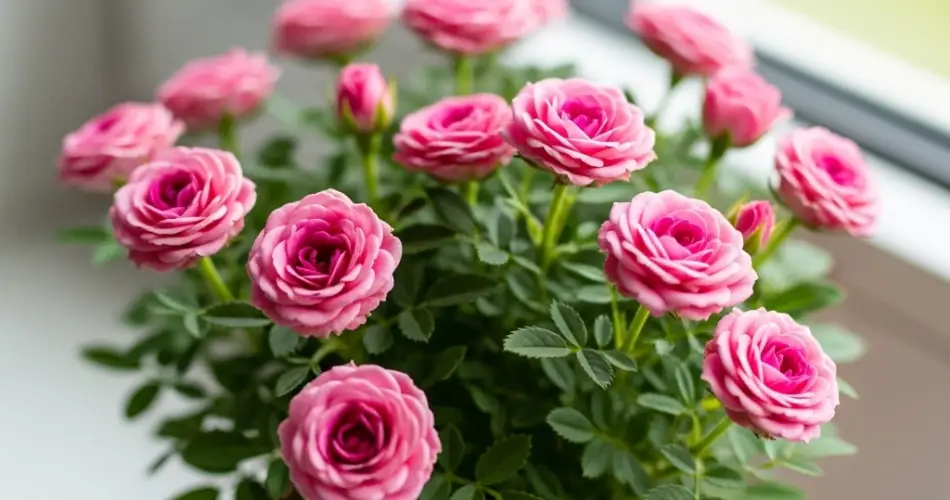Miniature roses, often called “mini roses” or by some popular varieties like PITIMINI, are charming, compact versions of traditional rose bushes. These delightful plants offer all the beauty and fragrance of regular roses but in a smaller size—making them perfect for indoor pots, small gardens, or balconies. Their petite blooms and neat foliage make them a favorite among gardeners who want the elegance of roses without the space requirement.
If you’re considering adding a miniature rose to your plant collection, or you already have one, understanding how to care for this delicate plant is essential for its health and continuous flowering. This guide covers everything you need to know about caring for miniature roses, including planting, watering, feeding, pruning, and protecting them from pests and diseases.
What Are Miniature Roses?
Miniature roses are true roses, just bred and cultivated to remain smaller and more compact. Unlike standard rose bushes that can grow several feet tall, mini roses typically grow between 6 to 24 inches in height. They produce smaller flowers but often bloom more abundantly and continuously throughout the growing season.
Their petite size allows gardeners to grow them indoors in pots or outdoors in confined spaces, making them very versatile. The PITIMINI variety is a popular mini rose known for its vibrant blooms and bushy growth habit.
Light Requirements
Miniature roses need plenty of bright, direct sunlight to thrive and flower well. Ideally, they should receive at least 6 hours of direct sunlight each day. If grown indoors, place them near a south-facing window where they get maximum light.
Insufficient light can cause weak growth, fewer blooms, and increased susceptibility to disease.
Soil and Planting
Mini roses prefer well-draining soil rich in organic matter. A good potting mix for roses or a garden soil amended with compost or peat moss works well.
If planting in pots:
-
Choose containers with drainage holes to prevent waterlogging.
-
Use a pot that is at least 6–8 inches deep to allow root development.
-
Repot every 1–2 years to refresh the soil and promote healthy growth.
When planting outdoors, space mini roses about 12 to 18 inches apart to allow airflow and room for growth.
Watering
Consistent moisture is important but avoid overwatering, which can cause root rot. Water when the top inch of soil feels dry. During hot or dry weather, watering might be necessary every day or every other day, especially for potted roses.
Water the soil directly rather than wetting the foliage to reduce the risk of fungal diseases. Early morning watering is best to allow leaves to dry during the day.
Fertilizing
Feed your miniature rose regularly during the growing season to encourage blooming and healthy foliage:
-
Use a balanced liquid fertilizer every 2–4 weeks.
-
Alternatively, apply slow-release granular fertilizer according to package directions.
-
Organic options like fish emulsion or compost tea are excellent and gentle.
Reduce feeding during the winter months when the plant’s growth naturally slows.
Pruning and Deadheading
Regular pruning keeps your mini rose tidy and encourages new growth and flowering:
-
Remove spent blooms (deadheading) to promote continuous blooming.
-
Cut back any dead, damaged, or weak stems.
-
After the flowering season, prune the plant to maintain shape and size—cut stems back by about one-third.
Always use clean, sharp pruning shears to avoid damaging the plant.
Pest and Disease Management
Miniature roses can be susceptible to common rose pests and diseases, but prompt care can keep your plant healthy:
-
Aphids: Small green or black insects that cluster on new growth. Spray with insecticidal soap or neem oil.
-
Spider Mites: Tiny pests that cause leaf yellowing and webbing. Increase humidity and spray affected leaves.
-
Powdery Mildew: White, powdery spots on leaves caused by fungal infection. Improve airflow and apply fungicides if necessary.
-
Black Spot: Dark spots on leaves that cause them to yellow and drop. Remove infected leaves and use preventive fungicides.
Maintaining good air circulation and avoiding overhead watering helps prevent many fungal issues.
Temperature and Humidity
Mini roses prefer moderate temperatures between 60°F and 75°F (15°C to 24°C). Avoid exposing them to temperatures below 40°F (4°C) or extreme heat above 85°F (29°C).
If grown indoors, maintain humidity levels around 40–60%. During dry seasons or in air-conditioned rooms, mist the plant occasionally or use a humidity tray.
Winter Care
In colder climates, miniature roses grown outdoors need protection:
-
Mulch around the base with straw or leaves to insulate roots.
-
Consider moving potted mini roses indoors before the first frost.
-
Reduce watering and stop fertilizing during dormancy.
With proper winter care, your mini rose will survive and bloom again in the next season.
Additional Tips
-
Rotate your potted mini rose occasionally to ensure even sunlight exposure.
-
Use stakes or supports if the plant grows tall or leggy.
-
Regularly inspect your plant for signs of stress or pests to act quickly.
-
Consider companion planting with herbs like basil or marigold to deter pests naturally.
Conclusion
Miniature roses like the PITIMINI variety are a wonderful way to enjoy the charm and fragrance of roses without needing a large garden space. With the right care — including ample sunlight, consistent watering, proper fertilization, and vigilant pest control — your mini rose can thrive and produce beautiful blooms all year round.
Whether kept indoors as a lovely centerpiece or planted outdoors in small gardens or patios, miniature roses bring joy, color, and elegance wherever they grow.
Start your miniature rose journey today and watch these petite beauties flourish!



